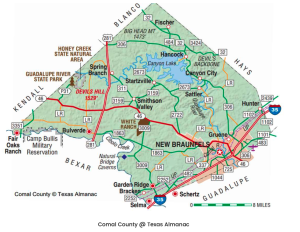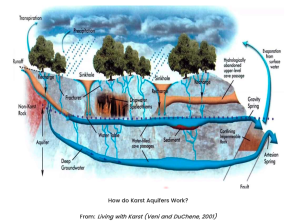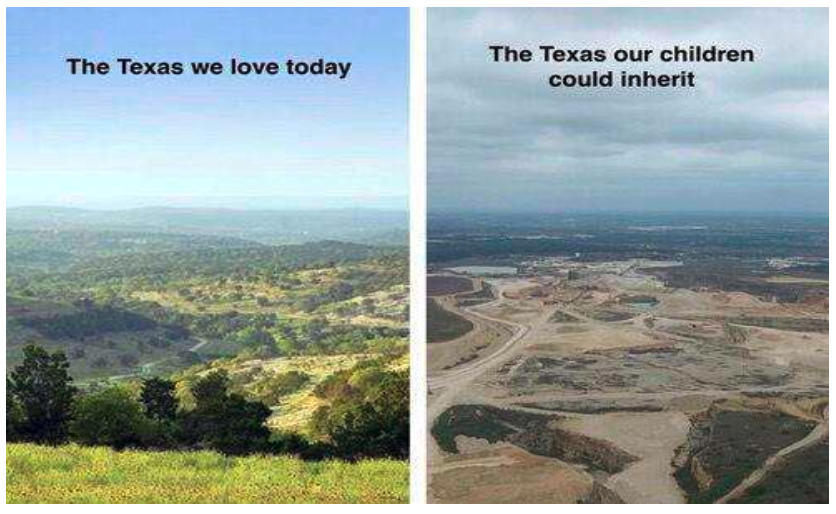I am Milann Guckian, president of Preserve our Hill Country Environment. This is not the job I asked for or wanted in retirement but one I felt I must undertake.
I’ve always known I wanted to come back to Central Texas to live out my days. Born in Lockhart, my family’s roots are embedded here. We had a vacation home on Canyon Lake where I spent many a day relishing the beauty of the hills, the rivers and lakes, the wildlife, and the peacefulness that came with these natural wonders.
In 1996, we found our little slice of paradise here in Comal County. We purchased five acres of land surrounded by all that I had come to associate with the Hill Country. We would be nestled amongst oak, cedar, and elm trees with an abundance of wildlife, birds, bats, and insects. Our neighbors to the southeast were our best friends, to the north-northeast sat a 600-acre family homestead and to the west-northwest sat the beautiful White Ranch.
White Ranch, 1500 acres (2.3 square miles) of pristine Texas Hill Country rangeland, sits in the middle of Comal County amidst caves, rivers and streams, wildlife, and fauna. The ranch sits under the migratory paths of bats, monarch butterflies and whooping cranes. Numerous legacy ranches and homesteads are nearby along with Indian remains and artifacts on neighboring properties and in adjacent caves.
The property extends southwest nearly three miles from the corner of State Highway 46 and Farm-to- Market 3009. This land is one of the largest pieces of undeveloped property in the county and is in unincorporated territory midway between New Braunfels and Bulverde. Of the utmost concern, White Ranch rests entirely over the Edwards Aquifer Recharge Zone (EARZ), and is unfortunately, in the crosshairs of the aggregate production operation (APO) industry in Texas.
 To understand the concerns of a quarry in the middle of the EARZ and how this will affect the Hill Country, Comal County, and New Braunfels, there needs to be a basic understanding of how the aquifer system works. Simply, we live on karst. Comal County is one of many counties that makes up the Balcones Escarpment in Texas. The escarpment is a karst formation. Karst is a terrain formed by dissolution of bedrock — in our area, this bedrock is limestone. The common features of limestone bedrock are sinkholes, caves, underground streams, and large streams or aquifers. Precipitation provides the groundwater that feeds the karst aquifer system.
To understand the concerns of a quarry in the middle of the EARZ and how this will affect the Hill Country, Comal County, and New Braunfels, there needs to be a basic understanding of how the aquifer system works. Simply, we live on karst. Comal County is one of many counties that makes up the Balcones Escarpment in Texas. The escarpment is a karst formation. Karst is a terrain formed by dissolution of bedrock — in our area, this bedrock is limestone. The common features of limestone bedrock are sinkholes, caves, underground streams, and large streams or aquifers. Precipitation provides the groundwater that feeds the karst aquifer system.
Karst is fractured and the millions of cracks and crevices throughout the limestone captures water, and over time, creates conduits. As the conduits enlarge, capturing more water, they can grow at ever- increasing rates until large enough for human entry. This is how Natural Bridge Caverns and Bracken Bat Cave were formed.
The water continues through these conduits to the underground streams or aquifers. Through the faults in the karst, water can then be carried to artesian springs. Prime example, the largest artesian spring in Texas is here in New Braunfels; Comal Springs.
Not only does White Ranch sit atop the EARZ but the West Fork Dry Comal Creek runs through it, converging downstream with the Dry Comal Creek before merging with the Comal River in New Braunfels. The Comal River is fed by springs from the Edwards Aquifer and is home to several endangered species. The clear, temperate waters of the Comal are widely used for recreational swimming and tubing activities before discharging into the Guadalupe River. Dry Comal Creek and Comal River are essential natural resources in Comal County, supporting economic development and recreation in the city, as well as agricultural operations and wildlife throughout the area.
The portion of the West Fork Dry Comal Creek that runs through White Ranch is the only section of the Dry Comal Creek and Comal River watersheds that is not polluted.
In 2010, TCEQ listed the Dry Comal Creek for impairment to its designated contact recreational use due to elevated Escherichia coli (E. coli) concentrations.
 Each of these water systems has a bearing on the other. The Dry Comal Creek and Comal River watersheds are also experiencing rapid urbanization, which adds another basis of pollution. Karst is vulnerable to pollution and the relationship between its many features —creeks, streams, aquifers, and caves—are complicated. Comal County has numerous waterways — Dry Comal, Cibolo, Rebecca, and Honey creeks; Comal and Guadalupe rivers; Comal and Hueco springs, the Trinity and Edwards aquifers; and Canyon Lake.
Each of these water systems has a bearing on the other. The Dry Comal Creek and Comal River watersheds are also experiencing rapid urbanization, which adds another basis of pollution. Karst is vulnerable to pollution and the relationship between its many features —creeks, streams, aquifers, and caves—are complicated. Comal County has numerous waterways — Dry Comal, Cibolo, Rebecca, and Honey creeks; Comal and Guadalupe rivers; Comal and Hueco springs, the Trinity and Edwards aquifers; and Canyon Lake.
If any of these water sources becomes polluted or is irreparably harmed, the others are in danger as well.
White Ranch, by its very location, is a notable component of the EARZ, and the Dry Comal Creek and Comal River drainage basins. A quarry sitting in the middle of all these water resources would present numerous challenges to these many interlinked systems, leaving our community exposed to water quality and quantity sustainability issues.
In 2017, Vulcan applied for an air quality permit with the Texas Commission on Environmental Quality (TCEQ). Area residents banded together to create an all-volunteer grassroots organization to contest the scientific and factual validity of the permit. Preserve Our Hill Country Environment (PHCE)and PHCE Foundation DBA Stop 3009 Vulcan Quarry and Friends of Dry Comal Creek were born.
February 27, 2018, TCEQ held a Public Meeting at the New Braunfels Civic/Convention Center. Over 500 residents, local and state leadership, and media showed up to support our efforts, voice their concerns and submit public comment for the permanent record.
December 2018, TCEQ granted our requests for a Contested Case Hearing (CCH) with the State Office of Administrative Hearings (SOAH).
March 6, 2019, SOAH Preliminary Hearing. There was standing room only in the Comal County Courthouse when the Administrative Law Judge (ALJ) extended the affected party boundary from one to five miles and granted AP status to all who had requested it.
June 2019, the Contested Case Hearing, lasting 3 days, was held in Austin. In August, the ALJ released a recommendation to TCEQ granting the air permit.
November 2019, TCEQ Commissioner’s granted the air permit. We filed a motion for rehearing on the permit citing the judge’s lack of consideration on the impact that the quarry would have on air pollution, increased truck traffic, decreased property values, endangered water quantity and quality, and other environmental issues. Also cited was the claim to “trade secret” allowed by the ALJ on Vulcan’s composite core sample used to determine silica content of the mining materials. The rehearing was not granted.
February 2020, we sued TCEQ in Travis County District Court. We asked the state to reevaluate the permit, noting that the agency ignored important environmental data and made legal errors when it approved the quarry in November 2019.
December 8, 2020, Hearing presided over by Judge Maya Guerra Gamble. Friends of Dry Comal Creek, Stop 3009 Vulcan Quarry v. Texas Commission on Environmental Quality (TCEQ) and Vulcan Construction Materials, LLC.
March 6, 2021, Judge Gamble struck down Vulcan’s air permit remanding the permit back to TCEQ. In April, TCEQ and Vulcan appealed that decision to the Third Court of Appeals.
Long story short, we followed the arcane “set to fail” process set forth by TCEQ and now the property’s future is in the hands of Texas courts. TCEQ stood with industry over citizens and issued the permit without adequately considering the impacts on the environment, our natural resources, and the health of the community, as required by state law.
Aggregate product is essential to the growth of Texas, but it is best produced in an industrial setting using common-sense, environmentally protective practices. The White Ranch is not an appropriate location. The sensitive features that comprise the White Ranch and ultimately affect the citizens of Comal County and New Braunfels need to be protected and preserved.
Understand what our Texas Hill Country stands to lose. For more information go to www.stop3009vulcanquarry.com. Support this worthy cause at the Bluebonnet Extravaganza Dinner & Auction: www.preserveourhillcountry.org/blue22 or donate at: https://www.preserveourhillcountry.org/
This article was written by Ms. Milann Guckian, President of Preserve our Hill Country Environment Foundation, and published in the New Braunfels Herald-Zeitung on January 22, 2022. You can read and download a PDF of the full article here. Republished on the HCA site with permission.

